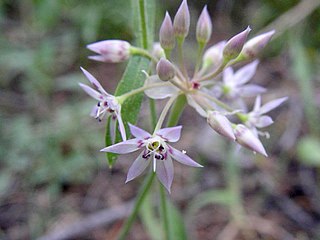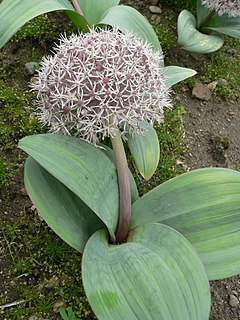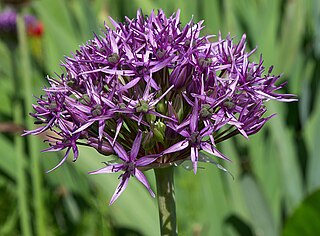
Allium canadense, the Canada onion, Canadian garlic, wild garlic, meadow garlic and wild onion is a perennial plant native to eastern North America from Texas to Florida to New Brunswick to Montana. The species is also cultivated in other regions as an ornamental and as a garden culinary herb. The plant is also reportedly naturalized in Cuba.

Allium campanulatum is a species of wild onion known by the common name dusky onion or Sierra onion. This is a flowering plant native to the western United States from southeastern Washington and northern Oregon to southern California, and western Nevada. The dusky onion grows in foothills and mountains, especially in dry areas, such as chaparral habitats.

Allium stellatum, commonly known as the autumn onion, prairie onion, cliff onion, or glade onion, is a North American species of wild onion in the Amaryllidaceae family that is native to central Canada and the central United States.
Allium przewalskianum is an Asian species of wild onion in the Amaryllis family.

Allium karataviense is an Asian species of onion in the Amaryllis family. It is commonly known as Turkistan onion or ornamental onion.
Allium plummerae is a species of plant native to southern Arizona in the United States and to Sonora in Mexico. It is known by the common names Plummer's onion and Tanner's Canyon onion. It grows on rocky slopes and stream banks in mountains regions at elevations of 1600–2800 m.
Allium korolkowii is a plant species native to Central Asia. It grows at elevations of 1500–2500 m.

Allium mongolicum is an Asian species of wild onion native to Mongolia, Inner Mongolia, Tuva, Kazakhstan, and parts of China.
Allium roborowskianum is an Asian species of wild onion native to Xinjiang and Mongolia. It grows at elevations of 1000–1300 m.
Allium schrenkii is an Asian species of wild onion native to Xinjiang, Kazakhstan, Mongolia and Siberia. It grows on steep slopes at elevations of 2400–2800 m.
Allium subangulatum is a Chinese species of wild onion, native to Gansu, Ningxia and Qinghai Provinces.
Allium tanguticum is a Chinese species of wild onion native to Gansu, Qinghai and Tibet. It grows at elevations of about 2000–3500 m.
Allium tenuissimum is an Asian species of wild onion native to Mongolia, Asiatic Russia, Korea, Kazakhstan and China.

Allium winklerianum is an Asian species of onion native to Xinjiang, Afghanistan, Tajikistan, Uzbekistan, Kyrgyzstan, and Tajikistan. It is also cultivated as an ornamental elsewhere because of the pretty flowers and also because of the strong lilac scent to the blooms.

Allium atropurpureum is a plant species native to Hungary, the Balkans, and Turkey. It is widely grown as an ornamental for its rich, deep purple flowers.

Allium subvillosum, the Spring Garlic, is a European and North African species of wild onion native to southern Iberia, the Balearic Islands, Sicily, northern Africa and the Azores where it might be introduced.

Allium sindjarense is a species of flowering plant in the Amaryllidaceae family.
Allium filidens is a species of onion found at high elevations of central and south-central Asia. It is a bulb-forming perennial up to 45 cm tall, forming a hemispherical umbel of flowers; tepals white or pink with a purple midvein.
Allium macrostylum is a Central Asian species of wild onion native to the Tien Shan Mountains in Kyrgyzstan. It is a bulb-forming perennial herb up to 30 cm tall. Leaves are flat, up to 15 mm wide. Umbel is spherical, with lilac-colored flowers.

Allium haemanthoides is a species of flowering plant in the Amaryllidaceae family. It is native to Iraq and Iran. It is a bulb-forming perennial with a densely packed umbel of white flowers with dark mideveins on the tepals.












